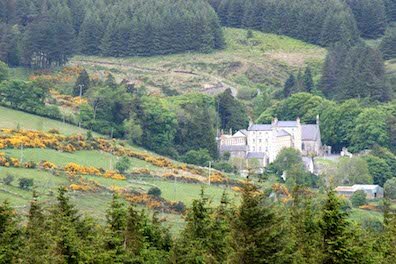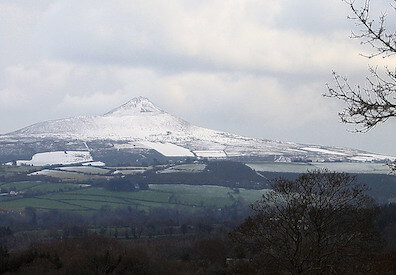Wicklow Mountains
Wicklow Mountains
In Brief
Only a few miles south and southwest of Dublin lie the
Wicklow Mountains, a wild area at the center of County Wicklow
that today is preserved as a 54,000-acre national park. Buck
Mulligan turns toward these "awaking mountains" at the
beginning of Telemachus, and Leopold and Molly
Bloom both remember a night when a jaunting car returned them
from a dinner at the "Glencree reformatory," passing over the
"featherbed mountain" that is part of the range. Other
chapters refer to a municipal water reservoir that lies on the
eastern side of the mountains, to the Poulaphouca waterfall on
the western side, to a separate County Wicklow mountain called
"the Sugarloaf," and to the ruined monastery at "Glendalough."
Read More
The northernmost Wicklow Mountains—sometimes called the Dublin Mountains or Dublin Hills—are visible from the top of the Martello tower on which Mulligan and Stephen Dedalus stand at the beginning of Telemachus. In a phenomenon familiar to anyone who lives near mountains or tall buildings, morning sunlight hits the tops of these hills before any of the surrounding countryside, so they seem to be "awaking" first.
The Blooms attended a fund-raising dinner at St. Kevin's Reformatory, a Catholic male reform school located about ten miles away in "Glencree," the second closest valley to Dublin on the east side of the mountain range. ("Glen" means "valley"; the nearest is called Glencullen.) The top of this valley is accessed by the Old Military Road, now the R115, that the British built in the first decade of the 19th century, north-south down the length of the range, to flush out United Irishmen rebels who were hiding in the hills. A barracks was built there in 1806 but closed down in 1815, and in 1858 the buildings were repurposed as a reform school. (The repurposing has continued. The Reformatory closed in 1940, and in 1975 the Glencree Centre for Peace and Reconciliation opened, to promote understanding between Catholics and Protestants in Northern Ireland during the time of the Troubles.)
After the dinner, in darkness, a car brought the Blooms back to Dublin from the Glencree reformatory over the nearby region that Dubliners called "the featherbed mountain," which is not so much a mountain as a high open plain. It may have gained its nickname because the cut-up blanket bogs on the high moorlands which the military road runs through give the land a ruffled appearance. Rolling across this wild, dark landscape Bloom pointed out various heavenly bodies to the other three people on the car while Lenehan fantasized about the heavenly body of Mrs. Bloom.
In Lestrygonians and Penelope the Blooms
recall a picnic at "the Sugarloaf." These
passages, and another in Cyclops, refer to one of
two Sugar Loaf mountains—most likely the "Great" or "Big"
one—in the eastern part of County Wicklow, very near Bray. They are even more
easily accessible from Dublin. Not part of the national park
area, these isolated peaks jut up on the other side of the
broad valley that borders the big Wicklow range on the east.
Ulysses makes several mentions of the "Roundwood"
municipal water reservoir that lies about halfway up this
broad valley. It was created in the 1860s by damming the
Vartry River—hence the mentions of "Vartry water" in Sirens
and Eumaeus. Bloom also recalls a school trip to a
waterfall at "Poulaphouca" on the Liffey,
about ten miles away on the western side of the Wicklow
Mountains. That area now holds another, even larger reservoir,
built in the 1930s and 40s by damming the Liffey. Both supply
clean, fresh water to the metropolis, and the construction of
the Vartry reservoir greatly reduced disease in 19th century
Dublin.
Finally, Ulysses briefly mentions "Glendalough,"
the famous monastery which St. Kevin founded in the 6th
century in a remote and inspiringly beautiful valley of two
lakes on the eastern edge of the mountains, about ten miles
southwest of the Vartry reservoir. The monastery appears in Cyclops
as just one in a long list of Ireland's scenic glories,
but Kevin becomes an important figure in Finnegans Wake.
His monastery flourished for six centuries until a gradual
decline in the 13th and 14th centuries, punctuated by the
destruction of most of its buildings by English forces in
1398.




